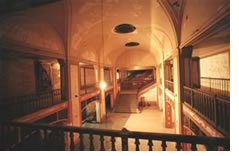

“Puttin’
on the Glitz” in Sioux City
Photographer documents Orpheum Theatre renovation
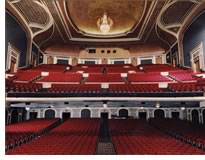 The
Sioux City Orpheum, designed originally by Chicago’s Rapp &
Rapp in 1927 and reopened in all it opulent glory after a 2001 redesign
by FEH Architects with theater restoration specialist Ray Shepardson,
GSI Architects, recently became a star in its own right. Filmmaker/photographer
and native Sioux Cityan George Lindblade has transformed more than 100
videotapes and thousands of photographs he shot over the last five years
into “Puttin on the Glitz,” a just-released documentary telling
the building’s rags-to-riches story “from neglected relic
to sumptuous showplace.”
The
Sioux City Orpheum, designed originally by Chicago’s Rapp &
Rapp in 1927 and reopened in all it opulent glory after a 2001 redesign
by FEH Architects with theater restoration specialist Ray Shepardson,
GSI Architects, recently became a star in its own right. Filmmaker/photographer
and native Sioux Cityan George Lindblade has transformed more than 100
videotapes and thousands of photographs he shot over the last five years
into “Puttin on the Glitz,” a just-released documentary telling
the building’s rags-to-riches story “from neglected relic
to sumptuous showplace.”
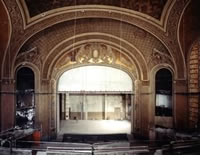 Shepardson
speculates that the Orpheum may be the most documented theater renovation
in the country. The new film tells the tale of a community committed to
restoring the Sioux City Orpheum to its rightful place as a premier architectural
and historical structure. As a native, Lindblade had watched the 2,600-seat
Orpheum, built as part of the vaudeville circuit, fall into decline. The
building, which boasted a three-story stage, suffered the further indignities
of a 1968 remodeling, then was split into twin movie houses in 1982. These
moves chopped off the theater’s balcony and added drop ceilings,
concealing intricate painting, plasterwork, and original light fixtures.
The theater, closed in 1992, faced the wrecking ball until it received
a total pardon, courtesy of the Orpheum Preservation Project, a civic
group that raised enough money to save the theater.
Shepardson
speculates that the Orpheum may be the most documented theater renovation
in the country. The new film tells the tale of a community committed to
restoring the Sioux City Orpheum to its rightful place as a premier architectural
and historical structure. As a native, Lindblade had watched the 2,600-seat
Orpheum, built as part of the vaudeville circuit, fall into decline. The
building, which boasted a three-story stage, suffered the further indignities
of a 1968 remodeling, then was split into twin movie houses in 1982. These
moves chopped off the theater’s balcony and added drop ceilings,
concealing intricate painting, plasterwork, and original light fixtures.
The theater, closed in 1992, faced the wrecking ball until it received
a total pardon, courtesy of the Orpheum Preservation Project, a civic
group that raised enough money to save the theater.
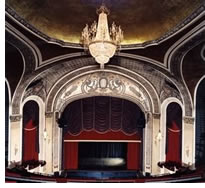 Through
“Puttin’ on the Glitz,” Lindblade, who has been a photographer
for 50 years, follows the Orpheum’s story thereafter, through its
successful $12 million restoration, to its “return engagement at
the heart of Sioux City’s cultural life.” He tells the impressive
tale of how the architects restored the ornamental plasterwork and finishes
to their original colors and characters while updating the systems and
making the space universally accessible. They restored or replaced the
theater’s 300 light fixtures, including its 30-foot-tall cut-crystal
chandelier. Perhaps not as visibly opulent, but certainly impressive structurally,
FEH engineered replacement of a 17-foot section of concrete balcony cut
away when the theater was divided into the twin cinema. The firm also
was able to recreate the original loges stripped away during the Orpheum’s
downsizing.
Through
“Puttin’ on the Glitz,” Lindblade, who has been a photographer
for 50 years, follows the Orpheum’s story thereafter, through its
successful $12 million restoration, to its “return engagement at
the heart of Sioux City’s cultural life.” He tells the impressive
tale of how the architects restored the ornamental plasterwork and finishes
to their original colors and characters while updating the systems and
making the space universally accessible. They restored or replaced the
theater’s 300 light fixtures, including its 30-foot-tall cut-crystal
chandelier. Perhaps not as visibly opulent, but certainly impressive structurally,
FEH engineered replacement of a 17-foot section of concrete balcony cut
away when the theater was divided into the twin cinema. The firm also
was able to recreate the original loges stripped away during the Orpheum’s
downsizing.
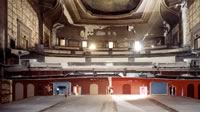 Today,
the Orpheum serves as a multipurpose performance hall, hosting
events this season that include a Singing
in the Rain film fest, CATS,
the Sioux City Symphony, and the Moscow Ballet’s Swan
Lake. And, as Lindblade’s tale and images testify, there
may be good reason if eyes wander occasionally from the stage to the magnificent
surroundings.
Today,
the Orpheum serves as a multipurpose performance hall, hosting
events this season that include a Singing
in the Rain film fest, CATS,
the Sioux City Symphony, and the Moscow Ballet’s Swan
Lake. And, as Lindblade’s tale and images testify, there
may be good reason if eyes wander occasionally from the stage to the magnificent
surroundings.
Copyright 2003 The American Institute of Architects.
All rights reserved. Home Page ![]()
![]()
 |
||
| Photos © George Lindblade For more information about “Puttin’ on the Glitz,” or to purchase videotapes or DVDs, contact Lindblade’s Sioux City office, 888-255-4346 or lndblade@pionet.net. Kudos to the “Putting on the Glitz” PR effort, which includes a copy of the video, neatly design (and clearly captioned) photo brochure, vellum press release, and a glitzy/Deco black-beaded folder for the papers. Grants from the Gerald L. and Kathleen A. Weiner Foundation and
the Iowa Arts Council helped support production of “Puttin’
on the Glitz.”
|
||
